Design and Modeling of Fiber-Free Optical MEMS Accelerometer Enabling 3D Measurements
Abstract
:1. Introduction
2. Functional Principle and Design
2.1. Mechanical Design and Modelling
2.2. Optical Design and Modelling
3. Computational Results
3.1. COMSOL Simulation of the Mechanical Performance of the Mass-Spring System
3.2. Optical Sensitivity Modeling Results
3.3. Total Specification
3.3.1. Total Sensitivity
3.3.2. Current Range
3.3.3. Noise and Resolution
4. Discussion
5. Conclusions
Author Contributions
Funding
Informed Consent Statement
Data Availability Statement
Conflicts of Interest
References
- Elies, S. Performance Analysis of Commercial Accelerometers: A Parameter Review. Sens. Transducers 2015, 193, 179. [Google Scholar]
- Shaeffer, D.K. MEMS inertial sensors: A tutorial overview. IEEE Commun. Mag. 2013, 51, 100–109. [Google Scholar] [CrossRef]
- Krishnan, G.; Kshirsagar, C.U.; Ananthasuresh, G.K.; Bhat, N. Micromachined High-Resolution Accelerometers. J. Indian Inst. Sci. 2007, 87, 333. [Google Scholar]
- Fiorillo, A.S.; Critello, C.D.; Pullano, S.A. Theory, technology and applications of piezoresistive sensors: A review. Sens. Actuators A Phys. 2018, 281, 156–175. [Google Scholar] [CrossRef]
- Ramadan, K.S.; Sameoto, D.; Evoy, S. A review of piezoelectric polymers as functional materials for electromechanical transducers. Smart Mater. Struct. 2014, 23, 033001. [Google Scholar] [CrossRef]
- Mukherjee, R.; Basu, J.; Mandal, P.; Guha, P.K. A review of micromachined thermal accelerometers. J. Micromech. Microeng. 2017, 27, 123002. [Google Scholar] [CrossRef] [Green Version]
- Chuang, W.-C.; Lee, H.-L.; Chang, P.-Z.; Hu, Y.-C. Review on the Modeling of Electrostatic MEMS. Sensors 2010, 10, 6149–6171. [Google Scholar] [CrossRef]
- Wu, W.; Li, Z.; Liu, J.; Fan, J.; Tu, L. A nano-g MEMS accelerometer for earthquake monitoring. In Proceedings of the 2017 19th International Conference on Solid-State Sensors, Actuators and Microsystems (TRANSDUCERS), Kaohsiung, Taiwan, 18–22 June 2017; IEEE: Kaohsiung, Taiwan, 2017; pp. 599–602. [Google Scholar]
- D’Alessandro, A.; Scudero, S.; Vitale, G. A Review of the Capacitive MEMS for Seismology. Sensors 2019, 19, 3093. [Google Scholar] [CrossRef] [Green Version]
- Medina, N.; de Vicente, J. Force Sensor Characterization Under Sinusoidal Excitations. Sensors 2014, 14, 18454–18473. [Google Scholar] [CrossRef] [Green Version]
- Rochus, V.; Westerveld, W.J.; Figeys, B.; Rottenberg, X.; Jansen, R. Simulation and Design of an Optical Accelerometer. In Proceedings of the 2019 20th International Conference on Thermal, Mechanical and Multi-Physics Simulation and Experiments in Microelectronics and Microsystems (EuroSimE), Hannover, Germany, 24–27 March 2019; IEEE: Hannover, Germany, 2019; pp. 1–6. [Google Scholar]
- Goel, S. (Ed.) Microelectronics and Signal Processing; CRC Press: Boca Raton, FL, USA, 2021; ISBN 978-1-00-316822-5. [Google Scholar]
- Berkoff, T.A.; Kersey, A.D. Experimental demonstration of a fiber Bragg grating accelerometer. IEEE Photonics Technol. Lett. 1996, 8, 1677–1679. [Google Scholar] [CrossRef]
- Zhao, Z.; Yu, Z.; Chen, K.; Yu, Q. A Fiber-Optic Fabry-Perot Accelerometer Based on High-Speed White Light Interferometry Demodulation. J. Light. Technol. 2018, 36, 1562–1567. [Google Scholar] [CrossRef]
- Huang, K.; Yu, M.; Cheng, L.; Liu, J.; Cao, L. A Proposal for an Optical MEMS Accelerometer with High Sensitivity Based on Wavelength Modulation System. J. Light. Technol. 2019, 37, 5474–5478. [Google Scholar] [CrossRef]
- Krause, A.G.; Winger, M.; Blasius, T.D.; Lin, Q.; Painter, O. A high-resolution microchip optomechanical accelerometer. Nat. Photonics 2012, 6, 768–772. [Google Scholar] [CrossRef] [Green Version]
- Li, R.-J.; Lei, Y.-J.; Chang, Z.-X.; Zhang, L.-S.; Fan, K.-C. Development of a High-Sensitivity Optical Accelerometer for Low-Frequency Vibration Measurement. Sensors 2018, 18, 2910. [Google Scholar] [CrossRef] [PubMed] [Green Version]
- Noell, W.; Clerc, P.-A.; Dellmann, L.; Guldimann, B.; Herzig, H.-P.; Manzardo, O.; Marxer, C.R.; Weible, K.J.; Dandliker, R.; de Rooij, N. Applications of SOI-based optical MEMS. IEEE J. Sel. Top. Quantum Electron. 2002, 8, 148–154. [Google Scholar] [CrossRef] [Green Version]
- Rong, Q.; Guo, T.; Bao, W.; Shao, Z.; Peng, G.-D.; Qiao, X. Highly sensitive fiber-optic accelerometer by grating inscription in specific core dip fiber. Sci. Rep. 2017, 7, 11856. [Google Scholar] [CrossRef] [Green Version]
- Shotorban, A.K.N.; Jafari, K.; Abedi, K. Optical MEMS accelerometer sensor relying on a micro-ring resonator and an elliptical disk. IET Circuits Devices Syst. 2019, 13, 1102–1106. [Google Scholar] [CrossRef]
- Abbaspour-Sani, E.; Huang, R.-S.; Kwok, C.Y. A novel optical accelerometer. IEEE Electron Device Lett. 1995, 16, 166–168. [Google Scholar] [CrossRef]
- Ahmadian, M.; Jafari, K.; Sharifi, M.J. Novel graphene-based optical MEMS accelerometer dependent on intensity modulation. ETRI J. 2018, 40, 794–801. [Google Scholar] [CrossRef]
- Tang, S.; Liu, H.; Yan, S.; Xu, X.; Wu, W.; Fan, J.; Liu, J.; Hu, C.; Tu, L. A high-sensitivity MEMS gravimeter with a large dynamic range. Microsyst. Nanoeng. 2019, 5, 45. [Google Scholar] [CrossRef] [Green Version]
- Lu, Q.; Wang, Y.; Wang, X. Review of micromachined optical accelerometers: From mg to sub-μg. Opto-Electron. Adv. 2021, 4, 03200045. [Google Scholar] [CrossRef]
- Wang, C.; Chen, F.; Wang, Y.; Sadeghpour, S.; Wang, C.; Baijot, M.; Esteves, R.; Zhao, C.; Bai, J.; Liu, H.; et al. Micromachined Accelerometers with Sub-µg/√Hz Noise Floor: A Review. Sensors 2020, 20, 4054. [Google Scholar] [CrossRef] [PubMed]
- Elwenspoek, M.; Wiegerink, R.J. Mechanical Microsensors; Microtechnology and MEMS; Springer: Berlin, Germany; New York, NY, USA, 2001; ISBN 978-3-540-67582-2. [Google Scholar]
- Cowen, A.; Hames, G. SOIMUMPs Design Handbook; MEMSCAP: Crolles, France, 2011. [Google Scholar]
- Kaajakari, V. Practical MEMS; Small Gear Pub: Las Vegas, NV, USA, 2009; ISBN 978-0-9822991-0-4. [Google Scholar]
- Boerner, W.M.; Brand, H.; Cram, L.A.; Gjessing, D.T.; Jordan, A.K.; Keydel, W.; Schwierz, G.; Vogel, M. Inverse Methods in Electromagnetic Imaging; Springer: Dordrecht, The Netherlands, 1985; ISBN 978-94-009-5271-3. [Google Scholar]
- ORSAM Opto Semiconductors SFH 4770S, IR SYNIOS P2720 (850 Nm)—120°. 2016. Available online: https://eu.mouser.com/datasheet/2/313/fsens01104_1-2279890.pdf (accessed on 30 December 2021).
- Moreno, I. LED irradiance pattern at short distances. Appl. Opt. 2020, 59, 190–195. [Google Scholar] [CrossRef] [PubMed]
- QP5.8-6 TO, Quadrant Photodetector Data Sheet, First Sensor. Available online: https://dammedia.osram.info/media/resource/hires/osram-dam-12599054/SFH%204770S%20A01_EN.pdf (accessed on 30 December 2021).
- ZHOU, X. An InGaAlAs-InGaAs Two-Colour Detector, InAs Photodiode and Si SPAD for Radiation Thermometry. Ph.D. Thesis, University of Sheffield, Sheffield, UK, 2014. [Google Scholar]
- McClain, R.L.; Wright, J.C. Description of the Role of Shot Noise in Spectroscopic Absorption and Emission Measurements with Photodiode and Photomultiplier Tube Detectors: Information for an Instrumental Analysis Course. J. Chem. Educ. 2014, 91, 1455–1457. [Google Scholar] [CrossRef]
- Ban, V.S.; Joshi, A.M.; Urli, N.B. Characterization of Process-Induced Defects in 2.6-µm InGaAs Photodiodes; Beltram, F., Gornik, E., Eds.; SPIE Digital: Cergy, France, 1993; p. 234. [Google Scholar]
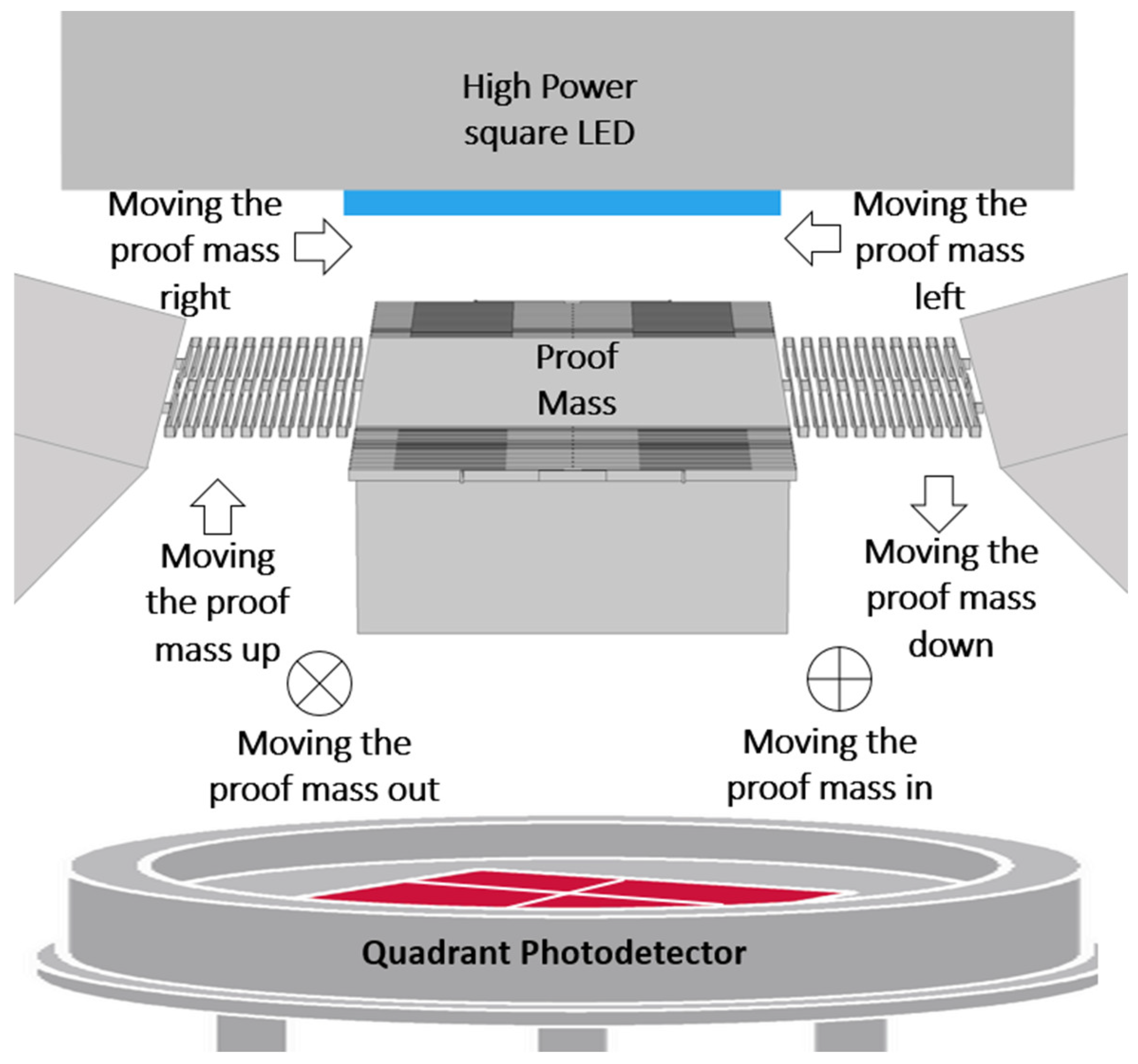
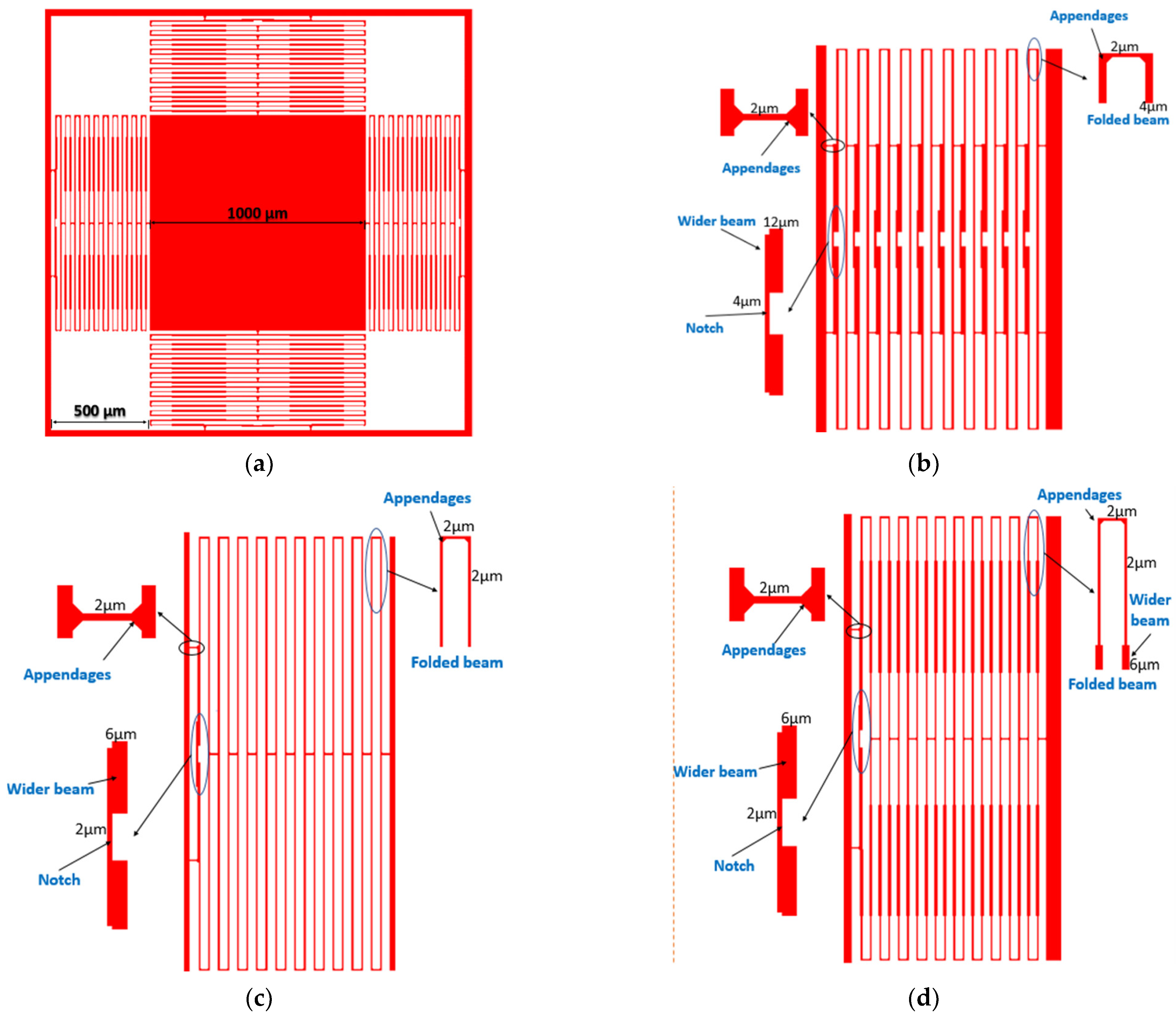
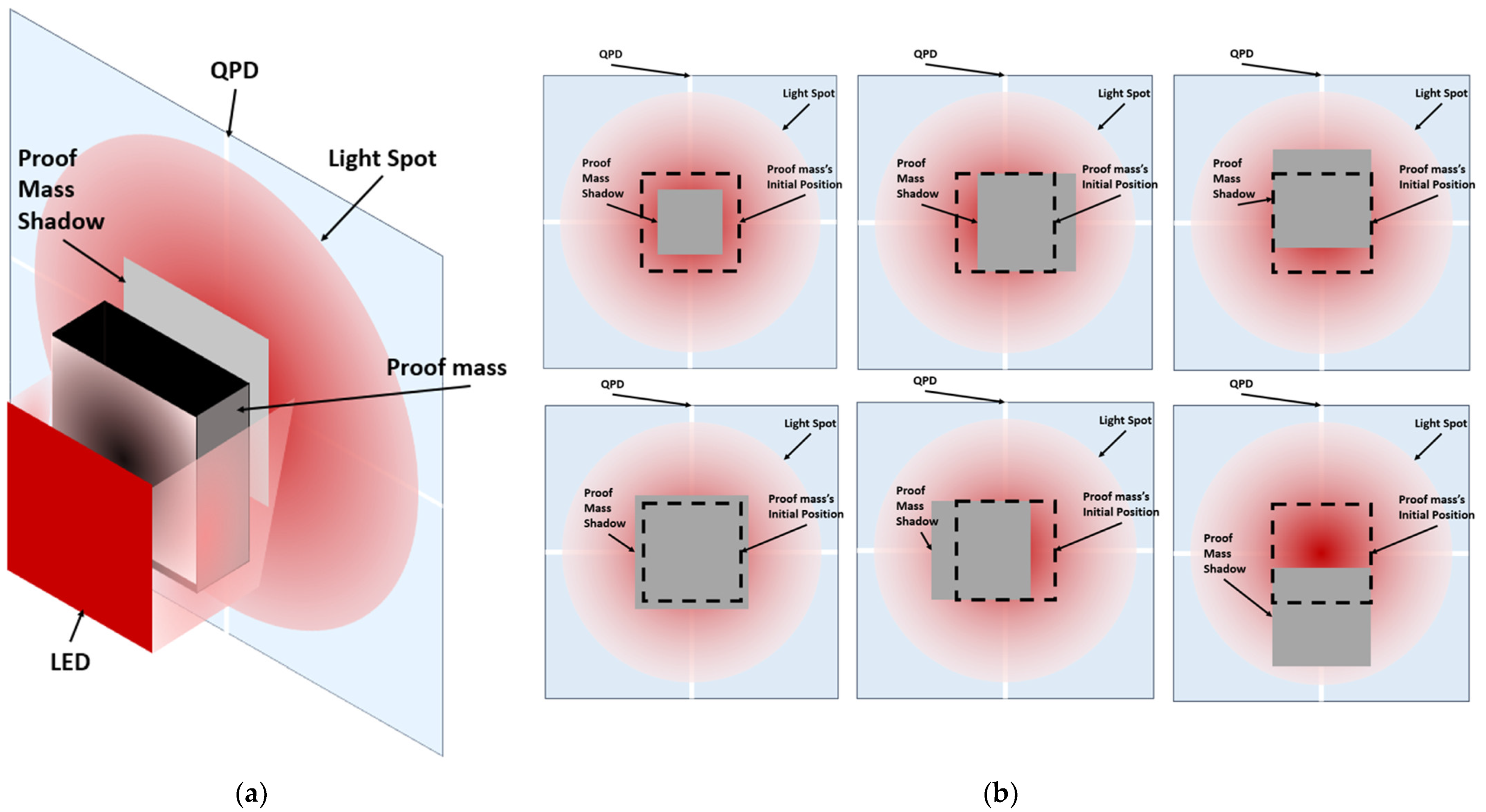
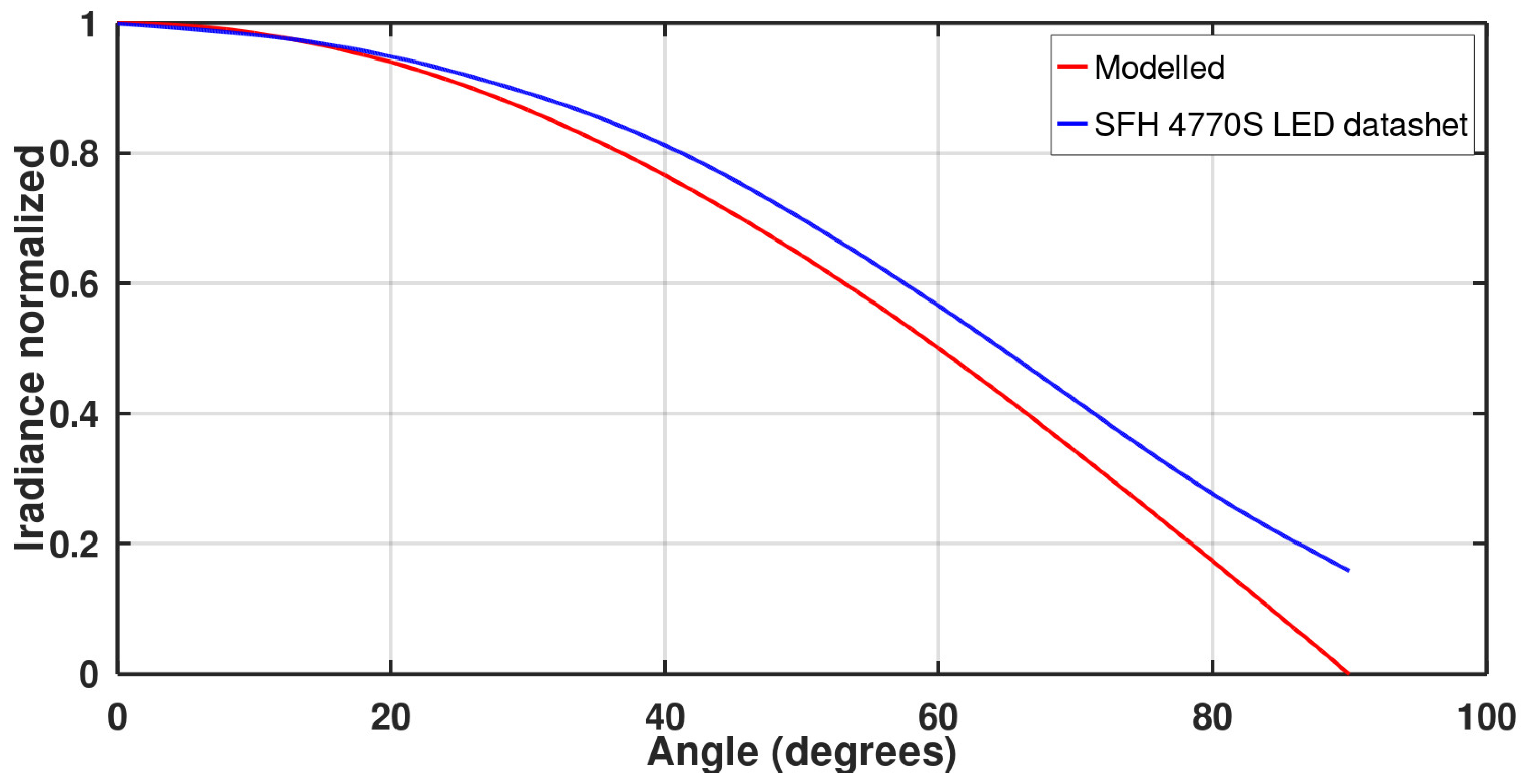

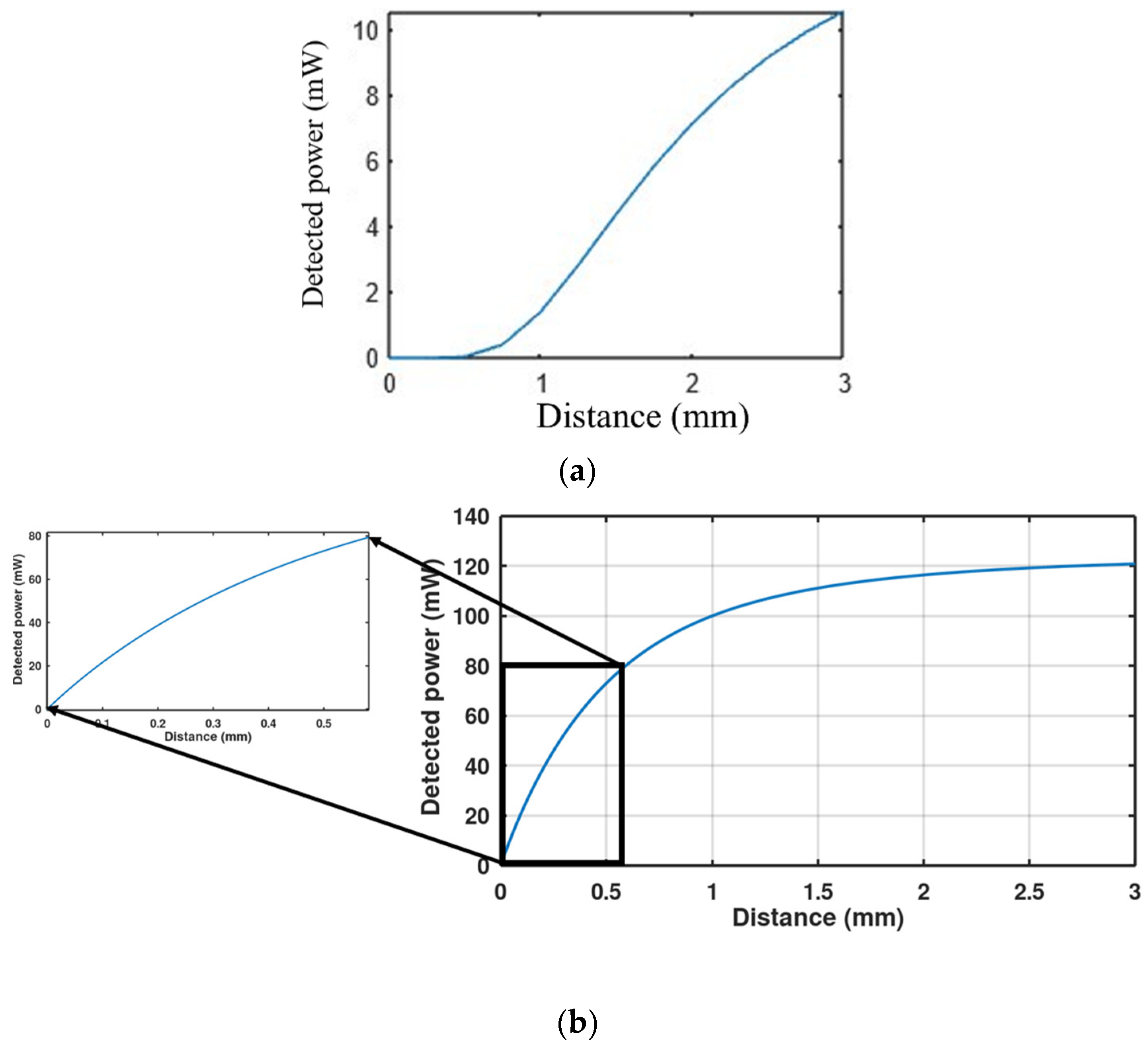



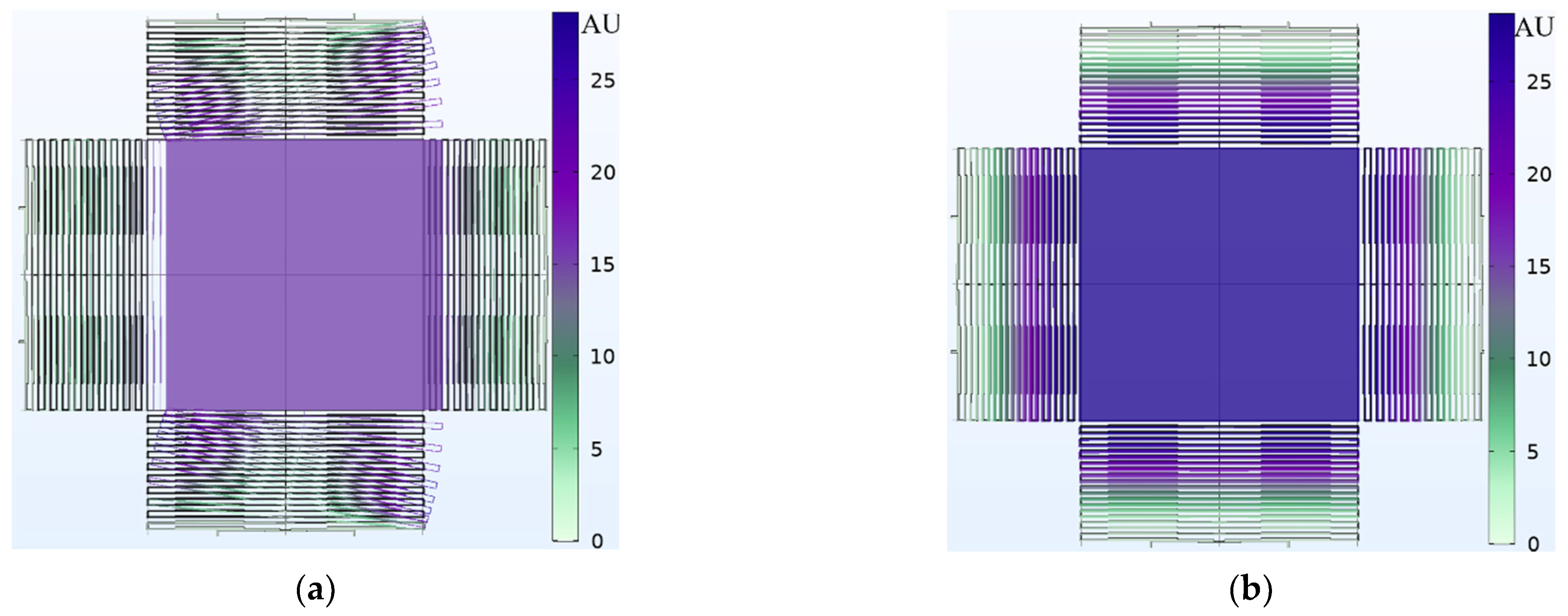



| Spec | Value |
|---|---|
| Current range | to 4 mA |
| Mechanical Bandwidth | 244 Hz |
| Maximum acceleration | ±10 G |
| Resolution | 56.2 μG |
| Vertical Sensitivity | μA/G |
| lateral Sensitivity | μA/G |
| Orientation | axial, dual axial or tri axial |
| Size (anodic bonding) | 1.5 mm × 4 mm × 4 mm |
| Size (off-shelf components) | 1 cm × 1 cm × 2 cm |
Publisher’s Note: MDPI stays neutral with regard to jurisdictional claims in published maps and institutional affiliations. |
© 2022 by the authors. Licensee MDPI, Basel, Switzerland. This article is an open access article distributed under the terms and conditions of the Creative Commons Attribution (CC BY) license (https://creativecommons.org/licenses/by/4.0/).
Share and Cite
Abozyd, S.; Toraya, A.; Gaber, N. Design and Modeling of Fiber-Free Optical MEMS Accelerometer Enabling 3D Measurements. Micromachines 2022, 13, 343. https://doi.org/10.3390/mi13030343
Abozyd S, Toraya A, Gaber N. Design and Modeling of Fiber-Free Optical MEMS Accelerometer Enabling 3D Measurements. Micromachines. 2022; 13(3):343. https://doi.org/10.3390/mi13030343
Chicago/Turabian StyleAbozyd, Samir, Abdelrahman Toraya, and Noha Gaber. 2022. "Design and Modeling of Fiber-Free Optical MEMS Accelerometer Enabling 3D Measurements" Micromachines 13, no. 3: 343. https://doi.org/10.3390/mi13030343







